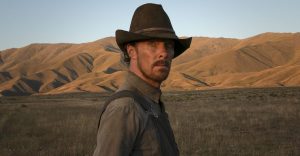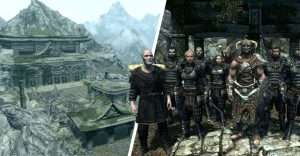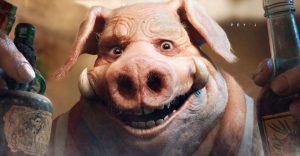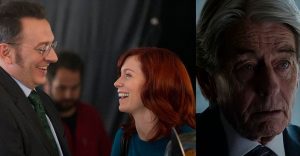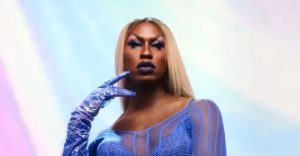15 Shocking Things You Never Knew About Futurama

Good news, everyone! Futurama is back, again… kind of. Matt Groening’s show has returned in the new mobile game Futurama: Worlds of Tomorrow. While the jury’s still out on whether the game is worthy of your time or money, now seems like as good an opportunity as any to revisit everyone’s favorite futuristic geek fest.
Groening’s follow-up to The Simpsons hasn’t had the easiest time, but Futurama has still managed to become an internet darling, remembered fondly as one of the smartest, most-loved animated shows ever. With multiple Emmys, a loyal following of nerdlingers, and merchandising that would make Calculon blush, Futurama has weathered three separate cancellations and come out the other side each time — once literally.
With almost twenty years gone since “Space Pilot 3000”, you’d be forgiven for forgetting a thing or two, especially since Netflix just unceremoniously yanked the early seasons from streaming. However, don’t you worry about forgetting any Planet Express trivia. Let us worry about blank.
So, if you’re ready, readers, pull up a groove and get fabulous. We’re about to do our best Roseanne and be Your Guide to the World of Facts.
Here are 15 Things You Never Knew About Futurama.
15 Thanks To Denial, They’re Immortal

Premiering in 1999, Futurama was a mainstay of the Fox Sunday night lineup for years. Despite being critically acclaimed, however, the show was often preempted by football or otherwise bounced around the schedule, before being cancelled in 2003.
This seemed like the end for our intrepid heroes, until Comedy Central came knocking. Five years after being cancelled, Futurama returned with a series of straight-to-DVD movies that were broken up and turned into the show’s fifth season, with Into the Wild Green Yonder serving as the show’s second series finale.
Unfortunately, that fifth season was too good, and Comedy Central was forced to bring back Futurama for two more full seasons in 2010, with “Meanwhile” serving as the show’s third and final finale in 2013.
Then again, the Planet Express crew’s never been particularly good at following orders.
They’ve since shown up in The Simpsons episode “Simpsorama” and two mobile games, the newest of which involves the original writers, cast, and animators. Just last week there was a Facebook live reading of “Proposition Infinity”, followed by a Reddit AMA with Matt Groening and the cast – where they hinted that Futurama might be coming back one more time.
14 The Episodes Were Broadcast Out of Order

Television shows have both production seasons where they actual make the show (writing, voicing, animating, etc.) and broadcast seasons when the show actually airs (fall premieres, midseason breaks, what have you). Usually, broadcast seasons match up pretty well with production cycles, for obvious reasons, but, over the years, Fox has seemingly gone out of their way to make sure shows don’t air in their intended order (see also: Firefly, The X-Files).
In fact, Futurama never had a full production cycle broadcast in its entirety. Thirteen episodes were made in the first season, while only nine aired; the remaining four weren’t broadcasted until the following year, during the second broadcast season. Things didn’t get better from there: when Futurama was first released on DVD, there were only four DVD sets, despite airing for five seasons.
This fifth season, specifically, was a mess. The producers of Futurama had no idea what episode was going to air as the finale, at one point presuming that the trippy giant bee episode “The Sting” might be the one to see them off. Thankfully, Fox went with “The Devil’s Hands Are Idle Playthings”, which was what the creative team had intended.
13 All Glory To The Hypnotoad (And Other Easter Eggs)

One of the best recurring jokes on Futurama is that the top-rated television show is Everybody Loves Hypnotoad, a thirty-minute program where an alien frog hypnotizes the audience. Brief snippets have been shown over the show’s run, but they’d never be crazy enough to make a full-length episode, right?
Think again, meatbag: one of the bonus features on the Bender’s Big Score DVD is, in fact, a twenty-two minute episode of Everybody Loves Hypnotoad, complete with titles, establishing shots, and commercials.
Other Easter eggs scattered across the various DVDs include a collection of posters for robot movies on Volume One, yearbook photos of all the creators on Volume Two, and a couple of table reads on Volumes Three and Four.
But wait, there’s more: the Monster Robot Maniac Fun Collection contains a hidden video of Al Gore recording his dialogue, Bender’s Game has a video of Billy West trying and failing to say a single line, and Into the Wild Green Yonder has a toilet paper animation of Bender drinking beer, and that’s just the tip of the Zoidberg.
12 The Creators Were Fined For Having Too Many Characters

The Simpsons is renowned for having far too many recurring characters, so it’s not surprising that Futurama followed in its older sibling’s footsteps. The show has close to one hundred recurring characters, and could certainly fill out the roster when needed.
In fact, during the end of Into the Wild Green Yonder, the creators tried to fit every character they’d ever animated on screen, topping out at over 250 distinct characters in one shot. They were actually fined for it by the animation studio, Rough Draft Studios, for wasting the animators’ time and, presumably, ruining some wrists.
With this many characters, it probably wouldn’t be surprising to find out that a good chunk of them have shown up in every episode. Heck, you’re probably thinking of several that did.
However, even with a main cast that included Amy, Hermes, Zoidberg, and Professor Farnsworth, only Fry, Leela, and Bender have actually appeared in every single episode, and the Planet Express ship, of course, can’t forget her. She would not take this well, no matter how many baby tapirs you distracted her with.
11 Green Lantern, The Brain, and Megatron All Voiced Characters

Besides voicing three of the main characters, Billy West actually managed to do them all at the same time. Most actors perform multiple readings for multiple characters, but not West – he’d switch from Fry to Farnsworth to Zoidberg, having whole conversations without taking a break. West’s also the man responsible for the voices of Ren and Stimpy, Doug, the red M&M, Bugs Bunny in Space Jam, and many others.
Phil LaMarr, who voices Hermes, is also the voice of Samurai Jack, Kit Fisto, and the John Stewart Green Lantern, and has appeared in front of the camera in Pulp Fiction and MADtv. Tress MacNeille’s voiced Babs Bunny, Agnes Skinner, Dot, and hundreds of others, plus she’s appeared in a Weird Al video.
Maurice LaMarche won an Emmy (twice) for voicing Calculon and Morbo, plus he’s The Brain on Animaniacs and Orson Welles everywhere. Frank Welker has been voice-acting since the ‘60s, speaking for Freddy on Scooby-Doo and Megatron in The Transformers.
John DiMaggio (Bender) is Jake on Adventure Time and Marcus Fenix in Gears of War. David Herman was in Office Space, and played Lauren Tom was on Friends.
10 Owls Are The Worst

Pizza-stealing rats and ravens committing Temple of Doom-style blood sacrifices might be the current scourge of New York City, but, in the future, owls are the disease-riddled pests at the top of the vermin food chain.
Throughout all seven seasons of Futurama, one of the more subtle running gags is that owls have replaced pigeons and rats in New New York. Owls can be seen crawling out of holes in the wall, picking through trash, and begging for breadcrumbs in the park. They’re such a nuisance in the future, there are even owl exterminators.
There’s the possibility that this was a riff on Philip K. Dick’s Do Androids Dream of Electric Sheep, where owls are extinct in the future; or even a spin on the old adage of sending cats to get rid of mice, until the farm is overrun with cats. Or, maybe someone was just a big Harry Potter fan.
9 Bender Really Is Great

Bender Bending Rodriguez has been many things over the years: a bending unit, a pharaoh, a terrible role model, Fry’s best friend, god, but he’s also been many “things” over the years. Allow us to elaborate.
Over the course of 140 episodes, Bender has been used as the following: a camera, a beer pump, a beer still, a mailbox, a butter dispenser, a grill, a cigarette lighter, a pager, a toilet, a timer, an amplifier, an answering machine, a time machine, a suntan lotion dispenser, an audio tape player and recorder, and a laser show projector.
Moreover, his body is made up of well over 300% different metals. Bender has, at various times, claimed that he was 40% zinc, 40% titanium, 30% iron, 40% dolomite, 40% chromium, 40% lead, 40% scrap metal, 40% wire, and 40% horseshoes, as well as 40% empty and %60 storage space, with a .04% nickel impurity.
And that’s why they call him Bender the Magnificent.
8 A Lot of Effort Was Put Into Things You’d Never Notice

In addition to casual sight gags, there are tons of small touches and jokes that no one in their right mind should have noticed.
In the very first episode, Fry lands in the future on December 31st, 2999. While he and Bender are fleeing Leela, they end up at the Head Museum, with Bender ordering him to “go in there, it’s free on Tuesdays.” Lo and behold, December 31st, 2999, actually is a Tuesday.
There were also several binary jokes: Bender’s apartment door number, 00100100, is binary for the $ symbol. In “The Honking”, 1010011010 is written on a mirror, translating to 666. Numbers were also written as mathematical equations whenever possible: Studio 1²2¹3³, Loew’s Aleph-null Plex, Pi Avenue, Historic Square Root 66.
However, it’s not just math getting all the geeky chuckles. Unnecessary history jokes are also littered throughout the show. In “A Head in the Polls”, there’s a Bull Space Moose Party booth hanging out in the background, seemingly manned by Bullwinkle. It’s a reference to Teddy Roosevelt’s Progressive Party, nicknamed the Bull Moose Party in the press.
Additionally, at the Head Museum, Grover Cleveland has two heads – because he had two non-consecutive terms as president.
7 Nibbler Was In The Pilot

With so much attention lavished on throwaway background jokes, it’s probably not surprising that the actual writing on the show was insanely detailed and planned out– we’re talking years in advance.
In the pilot, as Fry is falling into the cryogenic tube, Nibbler’s shadow can be seen beneath the desk, despite the fact that Nibbler doesn’t appear for three more episodes and his sinister plans aren’t revealed for three more seasons.
Similarly, Leela’s parents are seen standing in a crowd of mutants in the second season’s “I Second That Emotion”, despite the fact that Leela (and the audience) still think she’s an alien at that point. Her parents and her mutant origins aren’t revealed until the fourth season.
In season three’s “The Luck of the Fryrish”, Fry’s father talks about the legacy of the name Yancy, listing himself and his grandfather, but conspicuously leaving out his own father. Not until the following season’s “Roswell that Ends Well” do we finally learn the truth about the sordid (and incestuous) family history.
There’s more, but if we keep stopping to think ahead we wouldn’t be emperor.
6 Stephen Hawking Is A Fan

We mentioned earlier that the show’s got a ton of characters, but it’s also had its fair share of guest stars, too. Specifically, Futurama’s landed a number of big name scientists and sci-fi stars that wouldn’t normally deign to voicing a cartoon.
Famed physicist Stephen Hawking has appeared as himself three times on Futurama. Notably, he’s also appeared on The Simpsons, but not Family Guy (where they used an impersonator). Bill Nye and Neil deGrasse Tyson never appeared on the show, but they both appeared as themselves to introduce the new mobile game.
Gary Gygax, co-creator of Dungeons & Dragons was on the show, along with all the surviving members of the original Star Trek (except for Scotty), something that no one other show has managed.
Perhaps the biggest “get,” though, was sitting Vice President Al Gore. First appearing in “Anthology of Interest I” while he was still in office, he’s shown up several times afterwards. He’s even featured in a clip from “Crimes of the Hot” in An Inconvenient Truth.
Of course, given that the show received Environmental Media Awards for the episodes “The Problem with Popplers” and “The Futurama Holiday Spectacular”, Al Gore’s appreciation for Futurama isn’t surprising.
5 The Show Owes A Lot To The 1939 World’s Fair

For a science fiction cartoon made in the late 1990s and set in the thirty-first century, Futurama got an awful lot of its inspiration from the 1939 World’s Fair, which was the second largest American World’s Fair, with over 44 million people attending the exposition in Queens, New York from April 1939 to October 1940. The fair’s tagline was“The World of Tomorrow.”
Among the inventions showcased at the fair was a newfangled contraption called a television, presented by RCA but invented by a man named Philo T. Farnsworth. Hey, that name sounds familiar …
Also debuting at the fair was “Futurama,” General Motors’ transportation pavilion. Designed by famed theater designer Norman Bel Geddes, the exhibit was a glimpse into the distant future of 1959, an enormous interactive diorama of automated highways and sprawling suburbs.
We’re not sure exactly what Groening’s fascination with the 1939 World’s Fair was, but we’re glad it happened – the other titles he was throwing around for his show included Aloha Mars and Doomsville.
4 The Creators Made Up Two Alien Languages

Scattered across the backgrounds of most episodes, careful viewers will notice billboards and other signs written in a strange alien language. That language is known as “Alienese” and is, in fact, a code.
The original language first appeared in the pilot, on an advertisement that read “Drink Slurm” in English, with the alien glyphs beneath it. The creators had expected that some viewers might try to decipher the language, but they never expected that they’d do it that very night.
Never ones to step down from a challenge, the Futurama team created a second language, much more complicated than the first. While it didn’t happen that same night, the fans eventually deciphered this one too.
Rather than creating an all new third language, the creators simply started writing directly to the fans instead, specifically when they thought they were cancelled. On the fourth disc of the Volume Four DVD set, David X. Cohen included a lengthy note in Alienese, calling the fans nerdlingers, before admitting that he and most of the Futurama crew were also nerdlingers. Meanwhile, part of the opening credits of Into the Wild Green Yonder were also encrypted, defiantly stating “the humans shall not defeat us!”
3 The Writers Created A Mathematical Theorem

Not content with simply creating complicated alphabetical cyphers, the writers of Futurama also created an entire mathematical theorem, called, fittingly, The Futurama Theorem.
In “The Prisoner Of Benda”, the professor created a machine allowing the cast to switch bodies, but only one way. The writers, needing to get everyone back to their original bodies, had to actually invent a new mathematical theorem to do so. That mumbo-jumbo on the floating blackboard? Pure science, baby.
Of course, this wasn’t the only time they’d used a math problem for a plot point. Specifically, “Benderama” contains a more than passing reference to the Banach-Tarski paradox, a theorem that allows an object to spawn a perfect copy of itself using mathematical trickery.
Given that the writing staff held three Ph.Ds., seven master’s degrees, and cumulatively had more than 50 years at Harvard University, this probably isn’t that surprising. As series writer Patric M. Verrone stated: “we were easily the most overeducated cartoon writers in history.”
2 The Show’s Got A Lot Of Varied Influences

Let’s dive right into this. Turanga Leela is a reference to Messiaen’s “Turangalîla-Symphonie” from 1948, with “Turangalîla” itself deriving from two Sanskrit words meaning “love song.” Alternately, Matt Groening named Leela after Louise Jameson’s companion in Doctor Who. Leela’s tank top, meanwhile, was inspired by Sigourney Weaver in Alien.
Bender – aside from being clever wordplay about a bending robot prone to alcoholic sprees – is named after John Bender, Judd Nelson’s character from The Breakfast Club. News alien Morbo is modelled after the aliens in the 1957 flick Invasion of the Saucer Men, while Zoidberg is named after Zoid, a video game created by David X. Cohen in high school.
James Dean also gets a few shout-outs: The Wongs’ Mars ranch house is modeled after the house in Giant, while Fry’s ensemble is modeled after Dean’s outfit from Rebel Without A Cause.
Speaking of Fry, his first name is Philip, in honor of the late Phil Hartman, who was originally supposed to voice Zapp Brannigan. Brannigan himself is based on William Shatner.
Lastly, all of Futurama germinated from the song “Robot Blues” by Scottish folk group The Incredible String Band, easily the most unlikely source of inspiration for an Emmy-winning cartoon ever.
1 Seymour Is Based On A Real Dog

Get your tissues ready, because we’re talking about “Jurassic Bark”, the episode that actually received hate mail because of how sad it was.
Fry’s dog Seymour Asses was most likely based on Hachikō, an akita adopted by Hidesaburō Ueno, a professor at the University of Tokyo back in 1924. The prof would commute to work in the morning, and Hachikō would greet him at the train station every day when he returned.
Only, one day, Ueno suffered a cerebral hemorrhage and died, never returning home. For the next nine years, nine months and fifteen days, Hachikō waited for his master, appearing as the train arrived every day.
On the off chance you can still read through your tears: Hachikō wasn’t the only dog to wait for his dead master. There’s Argos, Odysseus’ faithful dog in The Odyssey. Fido was an Italian dog who waited 15 years for a master who was killed in World War II. Shep was another dog who waited at a train station for six years.
Honestly, the only way to make this better is to point out how much worse it could have been: the creators originally wanted to fossilize Fry’s mom, and we’re thankful that they chose not to.
—
Can you think of any other facts about Futurama? Anything seem like weapons-grade bolognium? Be like Cubert and let us know in the comments.
About The Author










